Flashcards aid in memory repetition of difficult to memorize plants that may show up on boards and in-service exam. This list will grow as I distill my readings and notes into only the highest yield memorization points.
note: all images used are public domain, unless otherwise cited within the flashcard
2nd note: you can zoom in on all images for a better picture, resolution is preserved
Latrodectus spp.: describe their general characteristics, habitats, pathophysiology, symptoms, and treatment modalities.
- *Lactrodectus mactans and geometricus are the black widow and brown widow, respectively.
- *Widows are found all over the United States (except Alaska), but seem to be more predominant in the south. The are also found abundantly across the globe in non-arctic regions.
- *Envenomation from the bite infiltrates a variety of insect/crustacean specific toxins and alpha-latrotoxin, which is a pore forming toxin at the presynaptic terminal. Ca2+ influxes as a result, leading to an exocytosis of neurotransmitters (eg, NE, dopamine, seratonin, GABA, glutamine, etc).
- *Pain can be local, regional, or systemic. Systemic manifestations involved generalized myalgia, headache, diaphoresis, and abnormal vital signs. Myopathy can also occur, which may progress to rhabdomyolysis and acute renal failure.
- *Indications for antivenom include high risk populations with severe symptoms, such as pregnant patients.
- *Treatment should predominantly involve benzodiazepines and opioid analgesics for moderate to severe symptoms. Minor symptoms can be treated with NSAIDs and cold packs.
- ***Bonus: females practice sexual cannibalism and eat the males after copulation.
L. Geometricus

Mfield, Matthew Field, http://www.photography.mattfield.com [GFDL 1.2 (http://www.gnu.org/licenses/old-licenses/fdl-1.2.html)]
L. Mactans
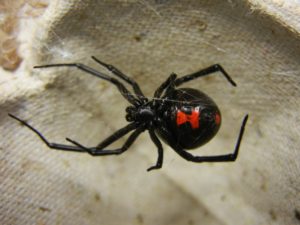
Shenrich91 [CC BY-SA 3.0 (https://creativecommons.org/licenses/by-sa/3.0)]
Describe important clinical features of Centuroides Exilicauda and Sculpuratus and (common name, features, pathophysiology, and treatment).
- Common name: bark scorpion
- Distributed in the Southwest US and Mexico
- Fluoresces with a black light
- Neurotoxin 1-4 cause membrane depolarization of neurons; the venom also contains hyaluronidase, phospholipase, and acetylcholinesterase
- Grading scale for envenomation
- 1: Paresthesias at bite site, positive “tap” test
- 2: Paresthesias at sites remote from the bite
- 3: Cranial nerve symptoms OR peripheral neuromuscular junction (NMJ) dysfunction (eg shaking).
- 4: Both cranial nerve symptoms AND peripheral NMJ symptoms
- Patients with 3 or 4 should get antivenom, as should high risk patients such as pregnant patients to prevent preterm labor
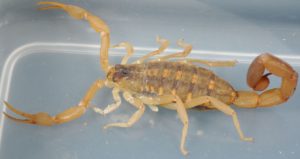
Charles & Clint [CC BY 2.0 (https://creativecommons.org/licenses/by/2.0)]
What are Loxosceles spp. Common name? Distribution? Venom mechanism?Clinical effects? Severe toxicity? Treatment?
- Brown recluse
- Loxosceles venom is a heterogenous medely of proteins including: sphingomyelinases, phospholipases, astacin-like metalloproteases, and the inhibitor cystine knot (ICK) peptides, serine proteases, serpins, hyaluronidases.
- Typically Loxoscelism is limited to local tissue necrosis, often patients will mistake an abscess for a bite of this spider.
- Mild systemic signs include: fever, flu-like symptoms, nausea/vomiting, disseminated rash
- Severe toxicity: intravascular hemolysis, hemoglubinuria or hematuria, DIC, hypotension, pulmonary edema
- Supportive care, wound care, steroids are controversial.
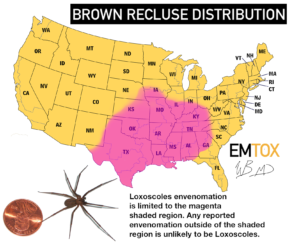
PMID:31248109
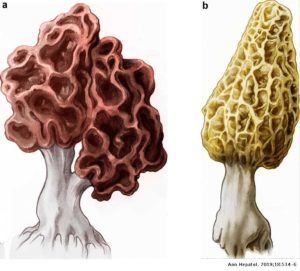
- Arłukowicz-grabowska, et al PMID=31014949
- Gyrometra Esculenta is a false morel.
- Contains hydrazine which depletes vitamin B6, a cofactor which is necessary for GABA synthesis by GAD. This can result in seizure.
- Treat with pyridoxine, similar to INH.
- Phenobarbital would be preferential because Benzodiazepines require the some endogenous GABA.
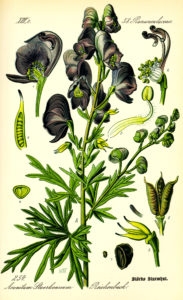
- Image above:
- Common names? Toxin? Mechanism? Symptoms?
- Monkshood, Friar’s cap, Wolfbane
- Aconitine: an alkaloid

- Sodium channel opener
- GI upset -> parasthesias -> confusion -> hypotension / ventricular arrhythmia
- Tx=supportive, lidocaine for dysrhythmia
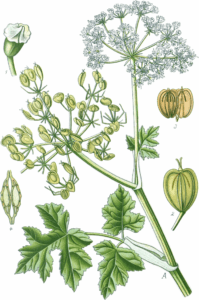
- Image above:
- Common name? Toxin? Effects? Treatment?
- Cow Parsnip, notable Heracleum Maximum in North America
- Furanocumarins: Angelicin (upper) and Psoralen (lower); note there are other isomers not shown
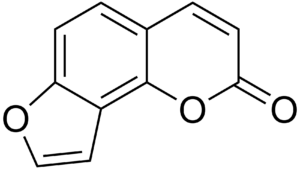
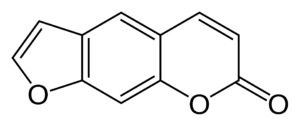
- Phototoxic vesicicular rash that form after exposed to sunlight. They intercalate with DNA leading to decreased robustness of DNA damage repair from UV sunlight.
- Treatment: supportive, wound care.

- Image above:
- Common name? Main active xenobiotic? Effects? Toxicity?
- .
- https://www.pinterest.com.mx/pin/383368987016954066/
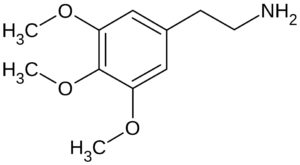
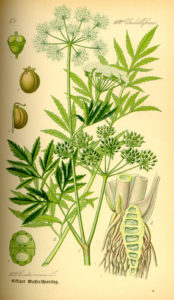
- The plant above:
- Common name? Mechanism? Demographic of victims?
Cicuta sp., particularly Cicuta Maculata, commonly known as water hemlock contain cicutoxin which directly antagonizes GABA-A receptors, resulting status epilepticus as soon as 15 min after ingestion.
Usually victims are adult foragers who mistake the plant for wild carrots or ginseng.
If soon enough after ingestion, can consider lavage. Benzos for seizures.
What are some plants with nicotine agonism paired with the presumed active xenobiotic?
- Nicotiana sp. = nicotine
- Cystisus scoparius = sparteine
- Caulophylum thalictroides = methylcystisine
- Cystisus Laburnum = cystisine
- Conium maculatum = gamma-coniceine and its plant metabolite coniine

- The above plant:
- Common name? Effect of toxin? Primary cause of death? Treatment? Historical significance?
- Poison Hemlock
- Nicotinic agonist: Coniine
- Respiratory muscle paralysis, seizure
- Tx= Atropine, mechanical ventilation
- Socrates ingested this at the order of the state for his subversive ideas
